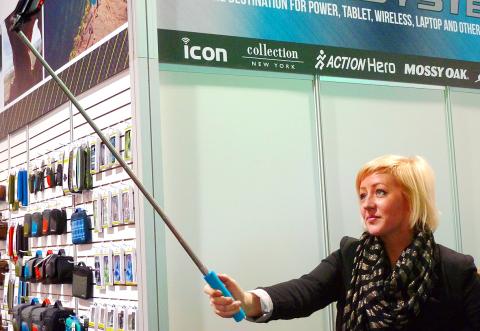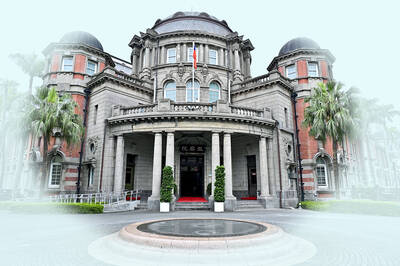“Selfie sticks” — the lightweight monopods which hold smartphones to get a better angle for self portraits — are making the tech community look at things from a new perspective.
These devices became a hot item at this week’s Consumer Electronics Show (CES) in Las Vegas, where dozens of manufacturers and distributors were fielding orders to meet consumer demand.
Priced as low as US$5, the selfie sticks took some of the limelight in a show that features US$10,000 television sets and other pricey hardware.

Photo: AFP/ Rob Leve
“They’re flying off the shelves, they are one of our hottest items,” said Katie Kunsman with the New Jersey-based manufacturer and wholesaler Motion Systems, at her booth at the Las Vegas tech gathering. Kunsman said the trend has taken off in the past few months, led by enthusiasts of extreme sports like rock climbing.
“If you go rock climbing you can get a picture from a good angle hanging off a cliff,” she said.
The origins of the selfie stick are unclear. Some say the trend began in Asia, others point to the extreme sports community and similar devices made for the GoPro camera.
“When I go to a music event, everyone has one,” said Aaron Sanchez at the stand for Mybat, a wholesaler of wireless accessories.
“You can take pictures from different angles that you wouldn’t be able to get otherwise, you can take group selfies. You can get everyone in the picture and you don’t have to ask someone to take it.”
The selfie sticks extend the smartphone camera away from the user by up to about 1.5m, providing a better angle than is possible by simply extending the device at arm’s length.
Some of the gadgets are sold at a very low price, but adding a wireless Bluetooth button to snap pictures can boost the cost to US$30 or US$40 or more.
Sometimes called “narcissticks” because they promote the self-centered picture trend, the devices have faced a ban in South Korea if they use unauthorized radio frequencies.
SELFIES ON CES FLOOR
On the CES show floor, Christina Hutchinson offered visitors a chance to snap a picture to promote “The Selfie Stick” sold by New York-based Lotp Marketing.
Lotp’s Robert Rickheeram said his firm began manufacturing and selling the sticks last year, after his parents bought one in Greece at the same time he found one in China.
“We were one of the first, although I can’t confirm we were the first” to start manufacturing and selling in the US.
“We recognized the trend and we were able to get the Web site theselfiestick.com.”
Rickheeram said it’s not clear if any single company can be dominant in the emerging stick sector.
“Anyone can make these,” he said. “There are no patents, although we have a patent pending.”
He said his device was designed with a strong clamp that holds the smartphone securely in place.
“It has a little more bulk, but we don’t want anyone breaking their US$500 smartphone,” he said.

That US assistance was a model for Taiwan’s spectacular development success was early recognized by policymakers and analysts. In a report to the US Congress for the fiscal year 1962, former President John F. Kennedy noted Taiwan’s “rapid economic growth,” was “producing a substantial net gain in living.” Kennedy had a stake in Taiwan’s achievements and the US’ official development assistance (ODA) in general: In September 1961, his entreaty to make the 1960s a “decade of development,” and an accompanying proposal for dedicated legislation to this end, had been formalized by congressional passage of the Foreign Assistance Act. Two

Despite the intense sunshine, we were hardly breaking a sweat as we cruised along the flat, dedicated bike lane, well protected from the heat by a canopy of trees. The electric assist on the bikes likely made a difference, too. Far removed from the bustle and noise of the Taichung traffic, we admired the serene rural scenery, making our way over rivers, alongside rice paddies and through pear orchards. Our route for the day covered two bike paths that connect in Fengyuan District (豐原) and are best done together. The Hou-Feng Bike Path (后豐鐵馬道) runs southward from Houli District (后里) while the

The Taipei Times last week reported that the Control Yuan said it had been “left with no choice” but to ask the Constitutional Court to rule on the constitutionality of the central government budget, which left it without a budget. Lost in the outrage over the cuts to defense and to the Constitutional Court were the cuts to the Control Yuan, whose operating budget was slashed by 96 percent. It is unable even to pay its utility bills, and in the press conference it convened on the issue, said that its department directors were paying out of pocket for gasoline

On March 13 President William Lai (賴清德) gave a national security speech noting the 20th year since the passing of China’s Anti-Secession Law (反分裂國家法) in March 2005 that laid the legal groundwork for an invasion of Taiwan. That law, and other subsequent ones, are merely political theater created by the Chinese Communist Party (CCP) to have something to point to so they can claim “we have to do it, it is the law.” The president’s speech was somber and said: “By its actions, China already satisfies the definition of a ‘foreign hostile force’ as provided in the Anti-Infiltration Act, which unlike